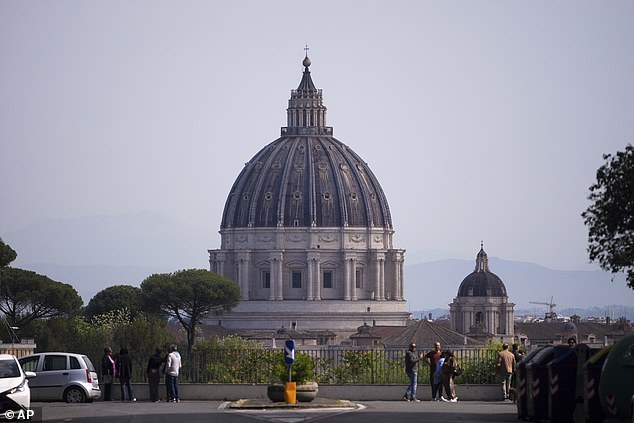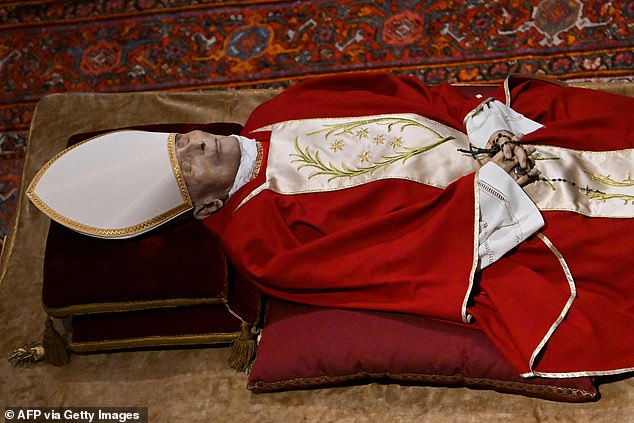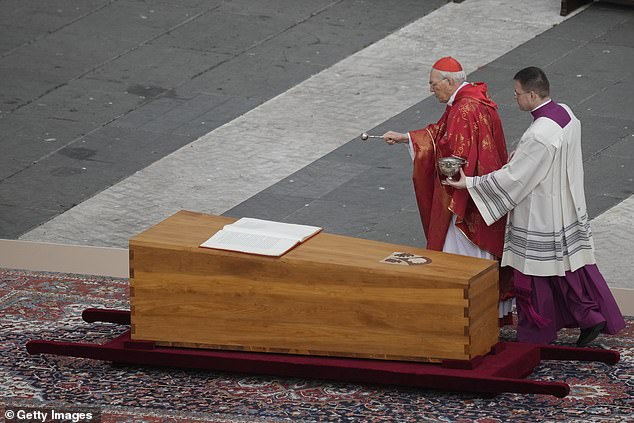Pope Francis‘s death will mark a significant break from traditional papal funerals – including how he will become the first pontiff to be buried outside of the Vatican in more than a century.
The pontiff’s death at 88 was announced by the Vatican on Easter Monday, two months after he was admitted to hospital with an infection that developed into pneumonia in both lungs and then kidney failure.
His death, which comes after 12 years as spiritual leader of the Roman Catholic Church, has plunged the world’s 1.4billion Catholics into mourning and sets into motion the centuries-old process of electing a new Pope.
There will now be nine days of official mourning, but the historic process of the conclave where cardinals will gather in the Sistine Chapel at the Vatican to choose who will be the next pope – will not begin for at least 15 days from today.
Although a papal funeral has traditionally been an elaborate affair, Pope Francis made the decision ahead of his death to approve plans to make it less complex.
While previous pontiffs, including the late Pope Benedict, have been buried in the traditional triple coffins made of cypress, lead and oak, Francis instead chose a simple wooden coffin lined with zinc.
The tradition of the Pope’s body being placed on a catafalque inside St Peter’s Basilica for the world to pay its respects has also been scrapped.
Francis’ body will instead remain inside the coffin, with the lid removed, with mourners invited to pay their respects.

Pope Francis on the main balcony of St. Peter’s basilica during the Urbi et Orbi message and blessing to the city and the world as part of Easter celebrations yesterday

Some 35,000 people turned out to cheer on the ailing Pope at St. Peter’s Square yesterday
The late pontiff will also become the first Pope in more than a century to be buried outside the Vatican.
He will instead be laid to rest in the basilica of Santa Maria Maggiore in Rome’s Esquilino neighbourhood, rather than in the grottoes beneath St Peter’s, which houses the tombs of around 90 popes.
The last Pope to be buried outside St Peter’s was Leo XIII (1878-1903) who was interred in the Basilica of St John Lateran, which is the church for the Bishop of Rome.
As a result, 22 other Popes are also buried here while another four are also resting at the Basilica of St Lawrence Outside the Walls.
These include Blessed Pius IX (1846-1878), St Zosimus (417-418), St Sixtus III (432-440), St Hilary (461-468) and Damasus II (1037-1048).
Five other Popes are buried at Santa Maria Maggiore and these include Pius V (1566-1572, Sixtus V, (1585-1590), Clement XIII ( 1758-1769), Paul V (1605-1621) and Clement IX (1667-1669).
Meanwhile, the Basilica of St Paul Outside the Walls houses the tombs of St Felix III (483-492) and John XIII (965-972).
Clement XIV (1769-1774) is buried in the Basilica of the Holy XII Apostles while Benedict XII (1724-1730) rests in the Basilica of Santa Maria Sopra Minerva.
A basilica is a church which has special significance or privileges granted by the Pope – and the Santa Maria Maggiore is one of the four major ones in Rome.
Francis has made more than hundreds of visits to the fifth-century basilica, where he would pray in front a venerated image of the Virgin Mary and baby Jesus.
In his final years, the pontiff appeared to be making plans for his death, consecrating 21 new cardinals – including details for his funeral.
When announcing plans to simplify his funeral, Francis told Mexican broadcaster N+ in 2023: ‘I’ll launch a new ritual.’
The stripping back of the papal funeral procedure is intended to ‘to emphasise even more that the Roman Pontiff’s funeral is that of a shepherd and disciple of Christ and not of a powerful man of this world’, according to Monsignor Diego Ravelli, the master of liturgical ceremonies.
It will come as no surprise to those who have followed Pope Francis’ journey since the start of his papacy in March 2013, when he opted against living in the lavish Apostolic Palace and instead moved into a guest house on the Vatican grounds.
He sought to project simplicity into the grand role and never took possession of the ornate papal apartments used by his predecessors, saying he preferred to live in a community setting for his ‘psychological health’.
Pope Francis previously presided the funeral of his predecessor, Pope Benedict XVI, who died in December 2022 after abdicating.
Benedict’s body lay in state in St Peter’s Basilica from January 2 to January 4 2023, with around 195,000 mourners paying their respects. His funeral was attended by around 50,000 people.
Benedict was among the previous popes to be buried in the traditional triple coffin made of cypress wood, zinc and oak.
It was was unprecedented in modern times for a living pope to bury his predecessor.
Announcing Pope Francis’s death today, Camerlengo Cardinal Kevin Farrell said in a statement: ‘At 7.35 this morning, the Bishop of Rome, Francis, returned to the home of the Father.
‘His entire life was dedicated to the service of the Lord and of his Church.
‘He taught us to live the values of the Gospel with faithfulness, courage, and universal love, especially for the poorest and most marginalised.
‘With immense gratitude for his example as a true disciple of the Lord Jesus, we commend the soul of Pope Francis to the infinite, merciful love of God, One and Tribune.’
The Pope emerged from his convalescence on Easter Sunday to bless the thousands of people in St Peter’s Square in Vatican City.
He had recently resumed some official duties during his recovery from pneumonia.
He made his first public appearance since his bout of double pneumonia on April 6, when he appeared in St Peter’s Square in a wheelchair during a special Jubilee Mass for the sick following his discharge from hospital two weeks previously.
The King and Queen visited the pontiff at the Vatican on April 9, the day Charles and Camilla celebrated their 20th wedding anniversary.

Popes are traditionally buried in the grottoes beneath St Peter’s Basilica (pictured) in the Vatican

But Pope Francis will be buried in the basilica of Santa Maria Maggiore in Rome’s Esquilino neighbourhood

In line with tradition, Pope Benedict lay in state inside St Peter’s Basilica (above, January 2023) and was then buried in a crypt underneath the building

Pope Francis blesses the coffin of Pope Benedict during his funeral on January 5 2023. Benedict was buried in the traditional triple coffin (pictured) but Francis will be buried in a simple wooden coffin lined with zinc
Archbishop of York Stephen Cottrell paid tribute to Francis, whom he described as ‘witty, lively, good to be with’.
He said in a statement: ‘Pope Francis was acutely aware of the divisions between our churches and how they stand in the way of seeing Jesus Christ more fully.
‘I remember the powerful work the Pope did with the then Archbishop of Canterbury, Justin Welby, and the Moderator of the Church of Scotland in promoting peacebuilding in South Sudan.
‘He was a listening Pope whose commitment to the principle and the process of synodality will be a permanent legacy to the Roman Catholic Church and to all of us.
‘I remember, in the brief times I spent with him, how this holy man of God was also very human. He was witty, lively, good to be with, and the warmth of his personality and interest in others shone out from him.
‘May he rest in peace and rise in glory.’







